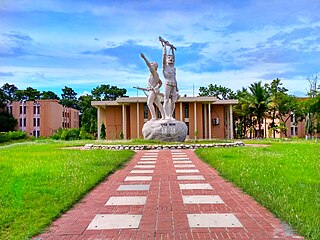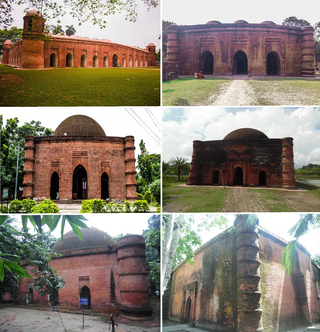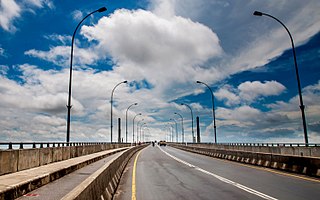
The Khulna Division is the second largest of the eight divisions of Bangladesh. It has an area of 22,285 km2 (8,604 sq mi) and a population of 17,416,645 at the 2022 Bangladesh census. Its headquarters and largest city is Khulna city in Khulna District.

Khulna is the third-largest city in Bangladesh, after Dhaka and Chittagong. It is the administrative centre of the Khulna District and the Khulna Division.It is the divisional centre of 10 districts of the division.Khulna is also the second largest port city of Bangladesh after Chittagong because of Port of Mongla.There is also a river port within the city named Port of Khulna.Khulna's economy is mainly marine and port based and it is the third-largest in Bangladesh,contributing $53 billion in gross regional domestic product and $95 billion in purchasing power parity (PPP) in 2020.

Jessore District, officially spelled Jashore District from April 2018, is a district in southwestern Bangladesh. It is bordered by India to the west, Khulna and Satkhira districts to the south, Khulna and Narail to the east, and Jhenaidah and Magura districts to the north. Jessore is the capital of the district. Jessore is the home of the ancestors of the great Bengali poet Rabindranath Tagore. Jashore was the first independent district of Bangladesh in 1971.

Bagerhat District is a district in south-western Bangladesh. It is a part of the Khulna Division.

The Mosque City of Bagerhat is a UNESCO World Heritage Site in Bagerhat District, Bangladesh. It contains 360 mosques, public buildings, mausoleums, bridges, roads, water tanks and other public buildings constructed from baked brick. The mosques were built during the Bengal Sultanate in the 15th century, of which the Sixty Dome Mosque is the largest. Other mosques include the Singar Mosque, the Nine Dome Mosque, the Tomb of Khan Jahan, the Bibi Begni Mosque and the Ronvijoypur Mosque. The mosques were built during the governorship of Ulugh Khan Jahan, a Turkic military officer appointed as governor in the Sundarbans by Sultan Mahmud Shah of Bengal.

Khan Jahan Ali or Ulugh Khān, was a Muslim saint and the Khan-i-Azam of Khalifatabad. It is believed that he built the great Mosque City of Bagerhat, now a UNESCO World Heritage Site.

Nāṣiruddīn Maḥmūd Shāh was the first Sultan of Bengal belonging to the restored Ilyas Shahi dynasty. Formerly a farmer, he was selected as the next ruler of Bengal by the erstwhile nobility in 1435 CE, and ruled the country for over twenty years. During his peaceful reign, Bengal saw significant architectural development.
Khan Jahan Ali Thana is a Metropolitan Thana of Khulna Metropolitan Police in the Division of Khulna, Bangladesh.
Government Majid Memorial City College is a college in Khulna, Bangladesh. The institute was established in the middle of the 19th century. It is beside the Khan Jahan Ali Road, near the "Royal er mor". It is a combined college offering 11th and 12th grades in three major subjects: science, commerce, and arts.
Khan Jahan Ali Airport is an planned airport in Bagerhat, Bangladesh. As it is very close to Khulna, it was planned to mainly serve the Khulna city. It is uncertain if the project will be completed as no work has been done since the beginning of the project in 1996, when, following the acquisition of the land and filling of the earth, funds ran out. The as-of-yet incomplete airfield will consist of a small terminal, two connecting taxiways and a north–south oriented runway with turntables at either ends so aircraft can backtrack down it.
The N7 is a Bangladeshi national highway connecting the Daulatdia Ferry Terminal, on the south bank of the Padma River near the Bangladeshi capital Dhaka, with the Port of Mongla in Bagerhat District. It serves some of the largest cities and towns in southwestern Bangladesh, including Faridpur, Magura, Jhenaidah, Jessore, and Khulna. The highway is known along various stretches as the Dhaka–Khulna Highway, the Jessore-Khulna Highway, and the Khulna-Mongla Highway.
Shankharikathi massacre refers to the killings of unarmed Hindu men by the Razakars in Shankharikathi market, Alukdia village of greater Khulna district in Bangladesh on 4 November 1971. 42 Hindus were killed in the massacre.

The Rupsa is a river in southwestern Bangladesh and a distributary of the Ganges. The Rupsa is one of the most famous rivers of Bangladesh.

Khan Jahan Ali Bridge is a bridge over Rupsa River in Khulna, Bangladesh and named after Khan Jahan Ali. The bridge is also known as Rupsa bridge.

Masjidkur Mosque is one of the archaeological sights of Bangladesh, located in Koyra Upazila of Khulna District. The Kapotaksha River is beside the mosque and very close to the Sundarbans.
Jogipol Union is a union parishad in Dighalia Upazila of Khulna District, in Khulna Division, Bangladesh.
Labanchara Thana is a thana of Khulna Metropolitan Police in the Division of Khulna, Bangladesh. It consists of the south part of Khulna city.










